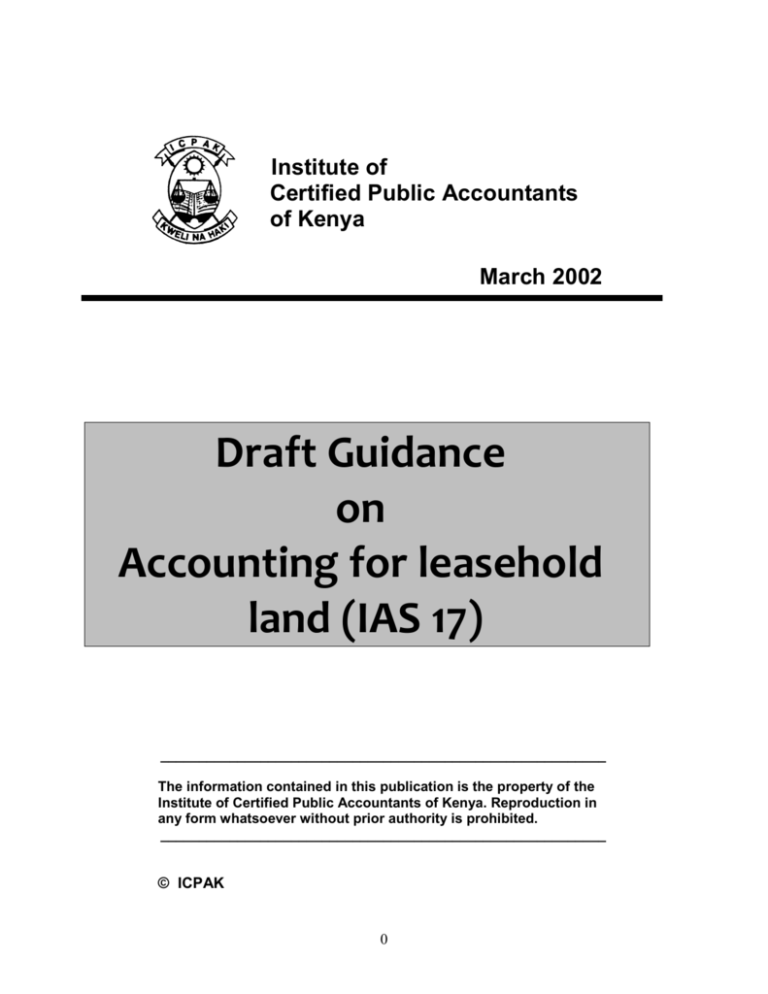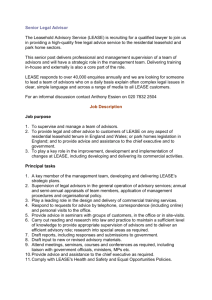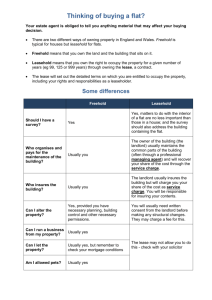Draft Guidance on Accounting for leasehold land (IAS 17)
advertisement

Institute of Certified Public Accountants of Kenya March 2002 Draft Guidance on Accounting for leasehold land (IAS 17) __________________________________________________________ The information contained in this publication is the property of the Institute of Certified Public Accountants of Kenya. Reproduction in any form whatsoever without prior authority is prohibited. __________________________________________________________ © ICPAK 0 Preamble Many enterprises in Kenya have land which is held under lease agreements with the Government or municipal councils. Such land has in the past been accounted for as property, plant & equipment (and in some cases revalued in line with the company’s policy on revaluation). However IAS 17 paragraph 11 states that these should be accounted for as prepayments under non- current assets and amortised/expensed over the lease period. This guidance clarifies the treatment of leasehold land and is in line with the IASB position which clarifies that when classifying a lease of land and building ,the lease should be split into two elements, a lease of land and a lease of buildings. The land element would be classified as an operating lease under paragraph 11 of IAS 17. The buildings element would be classified as an operating or finance lease by applying the normal conditions in IAS 17 A number of enterprises which have constructed buildings on the leasehold land may be inclined to feel that this justifies carrying the leasehold land under property, plant & equipment. However, paragraph 45 of IAS 16 states that: ‘Land and buildings are separable assets and are dealt with separately for accounting purposes, even when they are acquired together. Land normally has an unlimited life and, therefore, is not depreciated. Buildings have a limited life and, therefore, are depreciable assets. An increase in the value of the land on which a building stands does not affect the determination of the useful life of the building.’ Definitions of leases It is also necessary to determine whether acquisition of leasehold land is an operating lease or a finance lease. A finance lease is defined as a lease that transfers substantially all the risks and rewards incident to ownership of an asset. Title may or may not eventually be transferred. An operating lease is defined as a lease other than a finance lease. The issue at hand is whether to classify leasehold land as a finance lease or an operating lease. Paragraph 11 of IAS 17 clarifies the issue further: ‘Leases of land and buildings are classified as operating or finance leases in the same way as leases of other assets. However, a characteristic of land is that it normally has an indefinite economic life and, if title is not expected to pass to the lessee by the end of the lease term, the lessee does not receive substantially all of the risks and rewards incident to ownership. A premium paid for such a leasehold represents pre-paid lease payments which are amortised over the lease term in accordance with the pattern of benefits provided.’ Provisions of IAS 40 regarding leasehold land Some enterprises may argue that in Kenya, long leasehold land is tantamount to ownership because such land is held under long-term leases of up to 999 years. Appendix 1 B to IAS 40 provides further guidance on the issue. Paragraphs B10 to B15 are as outlined below: B10. IAS 40 does not permit a lessee to treat its interest in property held under an operating lease as investment property, even if the lessee acquired its interest in exchange for a large up-front payment or the lease has a very long term. Instead, IAS 17, Leases, requires the lessee to recognise the lease payments as an expense on a straight line basis over the lease term unless another systematic basis is more representative of the time pattern of the user's benefit.’ B11. In some countries, such as Hong Kong and the United Kingdom, enterprises commonly make a large up-front payment to acquire a long-term interest in property (sometimes known as a leasehold interest). Some lessees consider that a leasehold interest is, in economic substance, virtually indistinguishable from rights acquired on buying a property. Indeed, some commentators noted that outright ownership of land or buildings is impossible in some markets, such as Hong Kong, and that property "ownership" in these markets is invariably transferred by selling rights under operating leases. Some commentators, particularly from these countries, felt that lessees should be permitted to use the fair value model to account for such interests. B12. Some commentators suggested amending paragraph 11 of IAS 17, Leases, so that such leases could be classified as finance leases. This paragraph states that a lessee of land does not receive substantially all of the risks and rewards incident to ownership if title is not expected to pass to the lessee by the end of the lease term.’ B13. The Board found no conceptual basis for distinguishing one class of operating leases for which a fair value model might be appropriate from another class of operating leases where it might be more appropriate to continue the existing costbased accounting model under IAS 17. In particular, the Board concluded that an up-front payment does not change the economic substance of a lease sufficiently to justify an accounting treatment that differs from the treatment used for otherwise similar leases with no up-front payment. A distinction based on the presence or absence of an up-front payment is difficult to reconcile with the accrual basis of accounting.’ B14. The Board concluded that the Standard on investment property should not deal with property held under an operating lease and that IAS 17, Leases, should continue to deal with all operating leases. The Board also concluded that no other solution is practicable without a fundamental review of lease accounting. B15. Some commentators urged IASC to begin a fundamental review of lease accounting as soon as possible. The G4+1 group of standard setters is currently undertaking such a review and published a paper on this subject in December 2 1999. The Board is monitoring progress on this project with interest. However, the Board does not currently have such a review on its own work plan. In view of the foregoing, the following treatment will be applicable in the circumstances prescribed. 1. Leasehold land currently classified as property, plant and equipment 1.1 Previously revalued leasehold land Where an enterprise has previously revalued upwards the leasehold land, the appropriate treatment is to reverse the revaluation surplus relating to the leasehold land from the revaluation reserve account and transfer the leasehold land at depreciated cost to prepaid operating lease rentals under non-current assets. The amount so transferred will then be amortised/expensed over the remaining lease period. If deferred tax had been provided against the revaluation surplus, that should also be reversed. 1.2 Land not previously revalued but depreciated based on the original cost The appropriate treatment is to transfer the leasehold land at depreciated cost from Property, Plant and Equipment to prepaid operating lease rentals under non-current assets. The amount so transferred will then be amortised/expensed over the remaining lease period. 1.3 Where land has neither been revalued nor depreciated The appropriate treatment is to transfer the leasehold land at cost from Property, Plant and Equipment and to carry it in the balance sheet at cost less amortisation since inception of the lease as prepaid operating lease rentals. The amount of amortisation since inception should be presented as a prior year adjustment if material as provided under IAS 8 “ Net Profit or Loss for the Period, Fundamental Errors and Changes in Accounting policies”. The amount so carried in the balance sheet would then be expensed over the remaining period of the lease. 2. Leasehold land currently classified as Investment Property 2.1 Leasehold land under Investment Property may have been carried at cost of fair value. Carried at cost The appropriate treatment is to transfer the leasehold land at cost from Investment Property and to carry it in the balance sheet at cost less amortisation since inception of the lease as prepaid operating lease rentals. The amount of amortisation since inception should be presented as a prior year adjustment if material as provided under IAS 8 “ Net Profit or Loss for the Period, Fundamental 3 Errors and Changes in Accounting policies”. The amount so carried in the balance sheet would then be expensed over the remaining period of the lease. 2.2 Carried at fair value Where an enterprise had previously revalued upwards the leasehold land, the appropriate treatment is to reverse the fair value adjustment relating to the leasehold land by making a prior year adjustment and transfer the leasehold land at cost from Investment Property to prepaid operating lease rentals under noncurrent assets. 4



